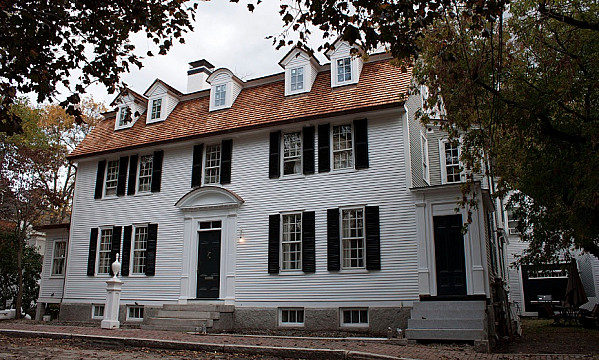General Porter House
32-34 Livermore Street, Portsmouth, New Hampshire
Built circa 1751, for Matthew Livermore (1703-1776) who retired from his legal career as Judge of the Superior Court of New Hampshire, and his wife Mary Rogers. The widowed Mrs Livermore sold the property to Nathaniel Sparhawk, Jr. (1744-1815) who left for England in 1786 and sold up to Joseph Russell, a Boston merchant who later married the beautiful Mrs Mary (Babcock) Gore whose portraitist (Gilbert Stuart no less) said, "Mrs Gore, my portrait of you is not half handsome enough, I wish you would sit to me again". In 1803, he sold to Congressman Edward St. Loe Livermore who developed Livermore Street and leased the house to Alexander Ladd (1784-1855)....

This house is best associated with...
Ladd's father-in-law, Congressman Nathaniel Appleton Haven (1762-1831), bought it in 1809 and four years later Ladd bought it from him. By 1818, the Ladds had moved to the Moffat-Ladd Mansion and rented out this house. In the early 1820s, it was rented to Captain John Porter and his wife Eliza Chauncy Clark, and it was here that their son, General Fitz-John Porter (1822-1901), was born and lived until 1825. Today, General Porter's statue stands opposite the house and it is for him for whom the house is named.
In 1833, Charlotte Haven Ladd, daughter of Alexander Ladd, married Samuel E. Coues (1797-1867) and they made their home in the house that has been her childhood home. Cous was a wealthy shipbuilder and merchant, but he is perhaps best remembered for his numerous humanitarian, charitable and intellectual endeavors. They lived here until moving to Washington D.C. in 1854, when they sold to Albert R. Hatch (1817-1882), "one of the most popular men in the city" whose family lived here until 1925.
Among those members of the Hatch family to live here was Rear Admiral James K. Cogswell. In 1925, the family sold the house to Admiral Douglas Eugene Dismukes (1869-1949) who'd won the Navy Distinguished Service Medal in 1918. During the Depression of the 1930s, he converted the mansion into two family homes. After changing hands several more times and after the addition of five dormers on the front of the house in 1981, it was given a much needed restoration in 1983 and converted into condominiums.
In 1833, Charlotte Haven Ladd, daughter of Alexander Ladd, married Samuel E. Coues (1797-1867) and they made their home in the house that has been her childhood home. Cous was a wealthy shipbuilder and merchant, but he is perhaps best remembered for his numerous humanitarian, charitable and intellectual endeavors. They lived here until moving to Washington D.C. in 1854, when they sold to Albert R. Hatch (1817-1882), "one of the most popular men in the city" whose family lived here until 1925.
Among those members of the Hatch family to live here was Rear Admiral James K. Cogswell. In 1925, the family sold the house to Admiral Douglas Eugene Dismukes (1869-1949) who'd won the Navy Distinguished Service Medal in 1918. During the Depression of the 1930s, he converted the mansion into two family homes. After changing hands several more times and after the addition of five dormers on the front of the house in 1981, it was given a much needed restoration in 1983 and converted into condominiums.
Categories
Styles
Share
Connections
Be the first to connect to this house. Connect to record your link to this house. or just to show you love it! Connect to General Porter House →


